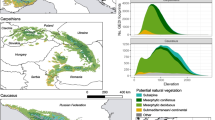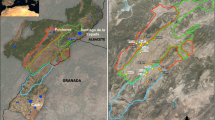Abstract
Context
A recent article in Landscape Ecology presented a method to true Moran’s I to its conceptual ideals and existing intuition regarding correlations. It’s scope included multiple methods, exploration of designed and empirical datasets, sensitivity analyses, and extensive mathematical treatment. The editor, reviewers, and lead author feared that the article due to complexity would not be accessible to empirical landscape ecologists.
Objectives
This perspective aims to highlight critical problems with the traditional autocorrelation metric and make standout material from the larger analysis accessible by paring to essentials and presenting a simple recipe to calculate an improved metric that also serves as a statistic.
Methods
Desirable traits for an autocorrelation metric were reviewed followed by distillation of best practices discerned in the larger project to attain those traits. A minimal method to obtain the superior metric was formulated.
Results
Moran’s I met only 2 of 14 desirable qualities for indexing autocorrelation. An improved metric was found to be achievable in 7 steps. The new metric, now a statistic, realized 14 of 14 desirable traits. The new statistic fit existing intuition for regular correlation and facilitated comparisons across disparate contexts.
Conclusions
Spatial autocorrelation is a common focus in landscape ecology. The new statistic enabled intuitive interpretation and meaningful comparison within and among studies. It provided for meta-analysis and meta-research, such as co-use with other spatial pattern statistics. These improvements should foster sustained use and impact of the new autocorrelation statistic Ir.

Similar content being viewed by others
Data availability
Example data and software to replicate this study are provided in Supplemementary file S1 and is also archived at the Open Access to Knowledge (OAK) digital repository at https://oaktrust.library.tamu.edu/handle/1969.1/194479.
Code availability
Not applicable.
References
Chen Y (2013) New approaches for calculating Moran’s index of spatial autocorrelation. PLoS ONE 8:e68336
Chen Y (2016) Spatial autocorrelation approaches to testing residuals from least squares regression. PLoS ONE 11:e0146865
Getis A, Ord JK (2010) The analysis of spatial association by use of distance statistics. Perspectives on spatial data analysis. Springer, pp 127–145
DeWitt TJ, Fuentes JI, Ioerger TR, Bishop MP (2021) Rectifying I: three point and continuous fit of the spatial autocorrelation metric, Moran’s I, to ideal form. Landscape Ecol 36:2897–2918.
Dale MR, Fortin M-J (2014) Spatial analysis: a guide for ecologists. Cambridge University Press, Cambridge, UK
Fuentes JI, DeWitt TJ, Ioerger TR, Bishop MB (2020) Irescale: Calculate and rectify Moran’s I. R package v. 2.3.0. https://cran.r-project.org/package=Irescale. Accessed 10 Dec 2020
Marrot P, Garant D, Charmantier A (2015) Spatial autocorrelation in fitness affects the estimation of natural selection in the wild. Methods Ecol Evol 6:1474–1483
Moran PAP (1950) Notes on continuous stochastic phenomena. Biometrika 37:17–23
Tobler W (1970) A computer movie simulating urban growth in the Detroit region. Econ Geogr 46(Supplement):234–240
Funding
Funded by a Triads for Transformation (T3) grant from Texas A&M University.
Author information
Authors and Affiliations
Contributions
Not applicable.
Corresponding author
Ethics declarations
Conflict of interest
The author declares no competing interests.
Ethical approval
Not applicable.
Consent to participate
Not applicable.
Consent for publication
Not applicable.
Additional information
Publisher’s Note
Springer Nature remains neutral with regard to jurisdictional claims in published maps and institutional affiliations.
Electronic Supplementary Material
Below are links to the electronic supplementary material.
Supplementary Material 1
Equivalence of summation and linear algebra I (DOCX 19kb)
Supplementary Material 2
Calculation of I and Ir (Excel file)
Rights and permissions
About this article
Cite this article
DeWitt, T.J. A simplified perspective on the index of spatial autocorrelation. Landsc Ecol 37, 657–661 (2022). https://doi.org/10.1007/s10980-021-01393-6
Received:
Accepted:
Published:
Issue Date:
DOI: https://doi.org/10.1007/s10980-021-01393-6




